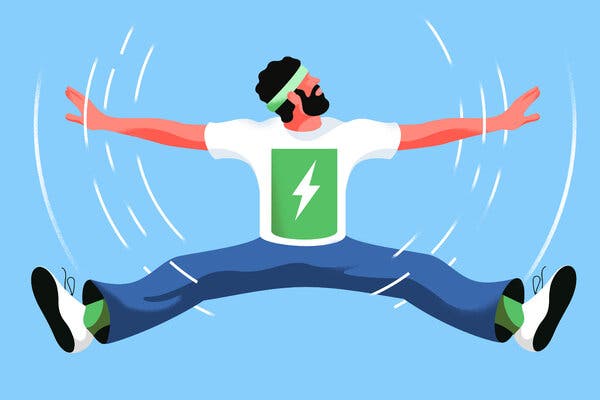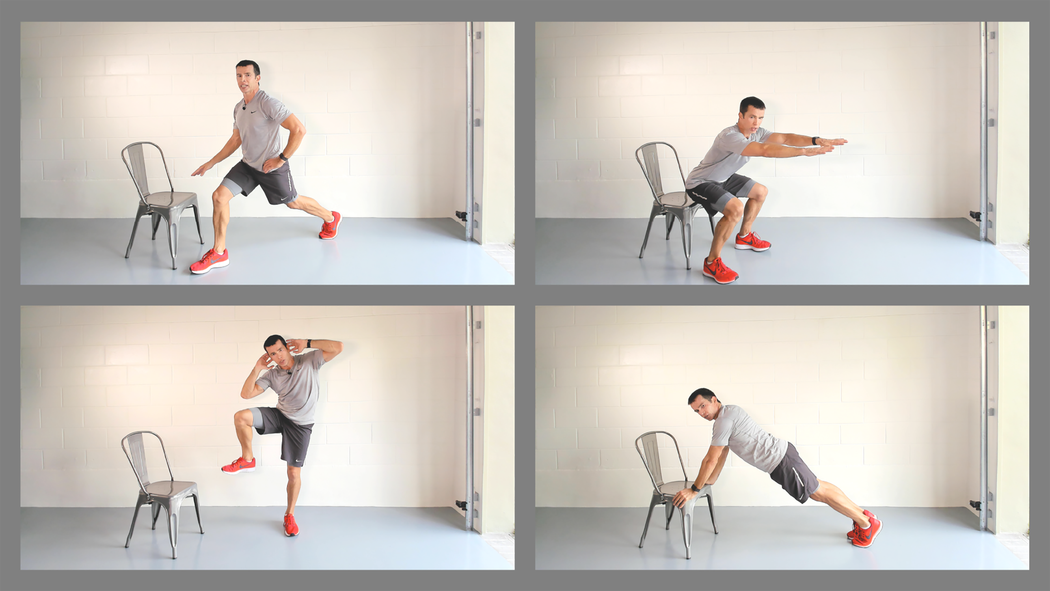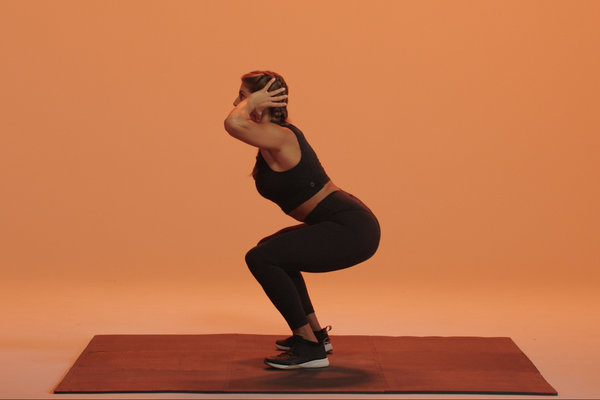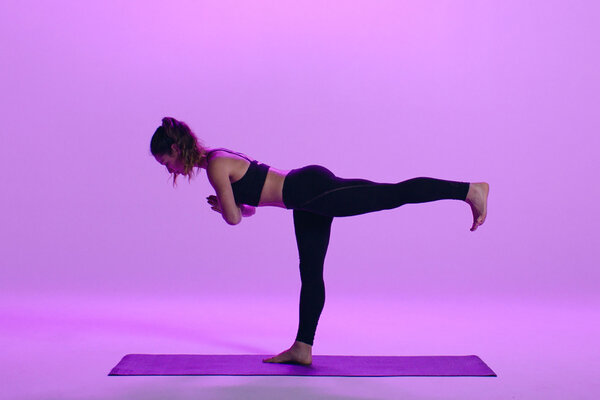Advertisement
Supported by
Reto del Nuevo Comienzo
Día 2: Vamos por un tentempié (de ejercicio)

El desafío
Hoy, en lugar de tomar un puñado de frituras o una galleta como por impulso, intenta que tu tentempié sea de ejercicio. Un bocadillo de ejercicio es una breve ráfaga de movimiento que puedes hacer en cualquier lugar, en cualquier momento. Ni siquiera hace falta que te cambies la ropa. Intenta 10 sentadillas contra la pared o 20 saltos de tijera. Haz una pausa para bailar o intenta la rutina de 7 minutos de pie. (Abajo tenemos videos y muchas más ideas para ti).
¿Por qué haría esto?
Un tentempié de ejercicio puede durar 20 segundos, un minuto o varios minutos. Puede parecer poco pero varios estudios científicos muestran que hacer ejercicio breve varias veces al día conduce a ganar en bienestar y salud generalizada.
Cuando unos investigadores en la Universidad McMaster en Ontario, Canadá, le pidieron a una docena de personas que tomaran una pausa de 20 segundos para ejercitarse tres veces al día solo tres días a la semana (subieron y bajaron las escaleras durante 20 segundos), los participantes incrementaron su capacidad aeróbica en un 5 por ciento después de seis semanas. ¿La clave para beneficiarse de este tentempié de entrenamiento? Cuanto más breve sea la pausa de ejercicio más debes aumentar el esfuerzo.
“Nos han condicionado a creer que el ejercicio es algo que se hace en un lugar especial una vez que te pones una licra, y es muy desalentador para la gente”, dijo Martin Gibala, profesor de kinesiología de la Universidad McMaster, cuyo ejercicio realizó el estudio sobre el tentempié de ejercicio. “Puedes estar activo, aunque signifique ajustar tu reloj para que te haga hacer sentadillas o sentarte contra la pared durante un minuto después de una hora de estar sentado”.
Inténtalo
1. El entrenamiento de 7 minutos de pie. Para esta pausa sencilla, de Chris Jordan, director de fisiología del ejercicio del Instituto de Desempeño Humano de Johnson & Johnson, todo lo que necesitas es una pared, una silla para mantener el equilibro y unos zapatos resistentes.
Back
transcript
The Standing 7-Minute Workout
All you need is a wall, a chair for balance and sturdy shoes for this workout from Chris Jordan, director of exercise physiology at the Johnson & Johnson Human Performance Institute.
Hi, everyone. Chris Jordan here, and welcome to my Standing 7-Minute Workout. No floor exercises, just a chair and a wall, and that’s all you need. We’re going to do 12 exercises, 30 seconds per exercise and 5 seconds’ rest in between. Remember, check with your doctor and make sure it’s safe for you to exercise before you start exercising. Don’t exercise if you think you’re going to experience any adverse effects. And of course, during exercise, stop straight away if you have any pains and problems. Make sure you get yourself warmed up and we’ll get started. All right, here we go with our first exercise — marching/jogging in place. Let’s go. Raise those knees. Pump those arms. This is a cardio exercise. The goal here, let’s get our heart rate up. If you can, let’s go into a jog, a jog in place. Pump those arms. Raise those knees. Get on to the balls of your feet. Pick up the pace, if you can. Looking good. All right, too much, then slow it down. Go back down to a march in place. Remember, just for your fitness level. 3, 2, 1. Done. Next exercise for the legs — chair assist squats. Here we go. Feet about shoulder width apart, knees slightly bent, then lower yourself towards the chair. Use your arms to counterbalance. Go as deep as you can go while maintaining good form and good technique. Keep those knees behind the toes. Can’t go so deep, that’s OK. Come down halfway. Beautiful. Keep going. Once again, use the arms to counterbalance. 3, 2, 1. Done. Time for something for the upper body. Let’s do a wall push-up. Hands against the wall, feet away, body straight from head to heel, and lower yourself and push away against the wall. Feel the arms, shoulders and chest work each time you lower and push yourself away. Too hard? Bring your feet a bit closer. Too easy? Bring your feet a little bit further away. You’re doing great. Keep breathing. We’re almost done. 3, 2, 1. Next exercise for the core — standing bicycle crunches. Hands behind the ears. Here we go. March in place, and bring the opposite elbow to the opposite knee. Twist your upper body and crunch the abs as you do so. Looking good. If you can’t touch the knee with your elbow, just do the best you can. Get as close as you can, but make sure you’re crunching the abs, bringing the upper body towards the lower body. 3, 2, 1. Done. Time for cardio exercise — stand or squat and box. Let’s go. Feet shoulder width apart, a bit wider, and punch. There’s your stand and box. If you can, let’s throw in a squat as well as a box. Looking good. Remember, the goal here — cardio. Let’s get that heart rate up again. Punch a bit faster. Squat a bit faster. Too much? Just stand still and punch. Here we go. Almost there. 3, 2, 1. Done. Move along. Time for the legs — chair assist split squat. Left foot in front, right foot behind. Drop the right knee towards the ground. Keep the front knee behind the front toes. There we go. Use the chair for balance and stability, if you need to. Beautiful. All right, switch legs. Right in front, left behind. Same movement. Drop the back knee towards the ground. Nice upright posture. Keep breathing. Adjust your range for your fitness level. 3, 2, 1. Done. Let’s move along. Time for an upper body exercise. Let’s do a chair assist push-up. Hands on the edge of the chair, feet away, and let’s go. Get that body straight from head to heel. Lower the body towards the chair, and feel the arms, shoulders, and chest work each time you lower and push away. Squeeze the abs, squeeze the core, squeeze the glutes and the legs to keep the body straight and stable. Almost there. Here we go. 3, 2, 1. Move along. It’s time to do another core exercise. Let’s do a wall plank. Forearms against the wall, feet away, body straight from head to heel. There’s your plank. You can do this on the floor, and you can do this against the wall. Same thing. Once again, too easy? Take your feet further away. Too hard? Bring your feet closer to the wall. You got this. Feel the abs work hard to maintain that body straight from head to heel. Squeeze the legs and the glutes too. 3, 2, 1. Time to move on. Next exercise — stepping or jumping jacks. Here we go. It’s cardio time. What’s the goal? Let’s get that heart rate up. Here’s the stepping jack. If you can, join me in a jumping jack. A little bit harder, higher impact, but it’ll get your heart rate up. If you can do this, do it. If you can’t, that’s OK, you go back down to a stepping jack. Let’s get the heart rate up, but do it safely. 3, 2, 1. Done. Time for a leg exercise. Let’s do a wall sit. Sit against the wall, knees directly above your ankles. Back flat against the wall, arms folded. Hold that position. Once again, you can adjust. Too hard? Come up a little bit higher. Too easy? Come down a little bit lower. You find the right level for you. Stick to it. You’ve got it. Feel the muscles of the upper legs working hard to keep you braced in position. You’ve got this. Here we go. 3, 2, 1. Done. Let’s work on the upper body again. We’re going back to the wall, wall push-up. Hands against the wall. You know what to do. Feet away, and lower yourself. Once again, feel the arms, shoulders, chest working hard as you push away and lower yourself back towards the wall. Keep breathing. And you know you can adjust your feet position to make it easier or harder. Almost there. Here we go. 3, 2, 1. Last exercise for the core — standing side crunch. Hands behind the ears. Watch this. Right knee to right elbow, left knee to the left elbow. Do the best you can to touch knee to elbow. If you cannot, that’s O.K., just do the best you can. Make sure you’re bending at the upper body and the core to bring the knee and elbow towards each other. You’ll feel this in the sides of the abdominals, a side crunch. Excellent. 3, 2, 1. Done. Congratulations. You just completed my Standing 7-Minute Workout. Great job. Come back and try it again.

2. Sentadillas con peso corporal. Este ejercicio básico fortalece las piernas y los glúteos. Solo tómate un descanso del trabajo algunas veces al día para hacer 20 segundos de sentadillas. Si deseas intensificarlo, impúlsate vigorosamente con cada sentadilla y haz que tus pies se levanten del piso.
3. Yoga. Si prefieres una actividad menos extenuante, intenta una pausa de yoga tres veces al día. Intenta elegir una postura que te desafíe pero que no te duela, como una plancha, una postura del árbol o del triángulo y mantenla durante un minuto si puedes. ¡Recuerda respirar!
4. Intenta una rutina de 6 minutos. Estos tres breves videos son fantásticos para principiantes pues te dan más tiempo para descansar entre un ejercicio y otro.
5. Ejercicios muy muy breves. Consulta nuestra guía en inglés de entrenamientos breves para encontrar el ejercicio perfecto.
6. ¿Las opciones anteriores son muy largas? ¡Intenta la rutina de 4 segundos! No, no estamos bromeando. Los estudios muestran que es posible ponerse en forma física con ráfagas frecuentes de ejercicios de solo 4 segundos.
7. Elige tu tentempié de ejercicio. Elige uno solo de los ejercicios de nuestra rutina de 9 minutos para tu tentempié de hoy.
Tara Parker-Pope es la editora fundadora de Well, el galardonado sitio de salud para el consumidor de The New York Times. Ganó un Emmy en 2013 por la serie de videos Life, Interrupted y es la autora de For Better: The Science of a Good Marriage. @taraparkerpope
Advertisement



